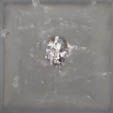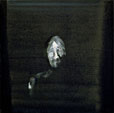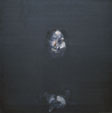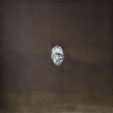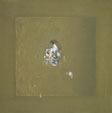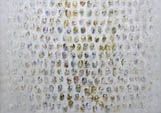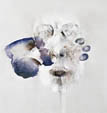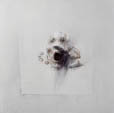Following a period of profound
dissatisfaction in which the artist destroys forty-three paintings, virtually
the years output (December1963). Anne Madden recounts: 'That blight most
dreaded by the artist had crept into him - the loss of inspiration. He
had painted himself to a standstill. The paintings he had made appeared
to him lifeless, contrived and without meaning, and at the end of the year
he did away with them. He felt depressed, powerless.' Le Brocquy himself
explains: 'Is it not the struggle of Jacob and the angel ? - the absolute
commitment of the painter to his material, in which he can be almost destroyed
by his material, defeated ... Sometimes the painter breaks away from the
struggle and comes away with nothing. Those are the moments when the work,
which is a record of the struggle, is destroyed by the artist, rejected.'
The crisis will lead to the emergence of the Head series to become
an enduring preoccupation over the next four decades. Discovers a vital
source of inspiration in Polynesian heads, Musée de l'Homme, Paris
(winter 1964). The artist is profoundly impressed by these objects reconstituting
the human presence. As he recalls: 'Skulls, partly remodelled with clay,
and then painted in a decorative way, often with cowrie shells for eyes'.
Anne Madden who accompanies the artist to the anthropological museum recounts:
'These head images suggested to him a new human significance. He felt the
over-modelling and painting implied a ritualistic laying on of hands, a
recognition of the ancestor's entity; palpable marks from the outside which
defined and celebrated the spirit within the reconstituted ancestral head'.
The event kindles le Brocquy's interest in the Celtic head culture: 'Like
the Celts I tend to regard the head as this magic box containing the spirit.
Enter that box, enter behind the billowing curtain of the face, and you
have the whole landscape of the spirit'. According to Dorothy Walker: 'The
crystallisation of his interest in the remote past into a twentieth-century
version of the old Celtic notion of the head as "the magic box that
contains the spirit" is an intensification of a fundamental obsession:
the desire to lay his finger on the pulse of the very earliest manifestation
of art in Ireland, somehow to absorb the autonomy of that anonymous art
into his creative energy and to re-show itforth in his own very different
work'. Embarks on the Ancestral Heads series (c.1964-1975) the fourth
distinctive period in the artist's work ... |



